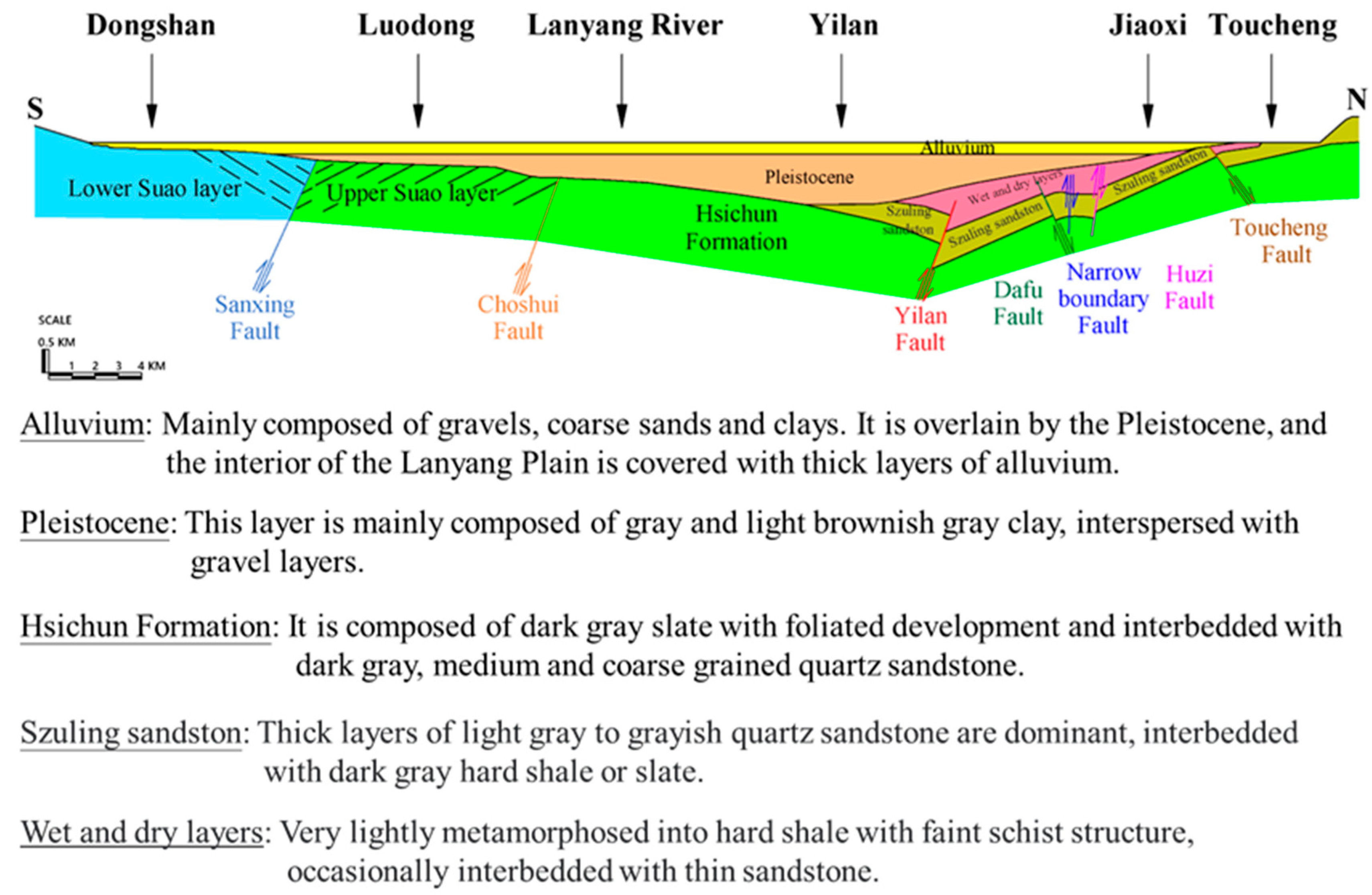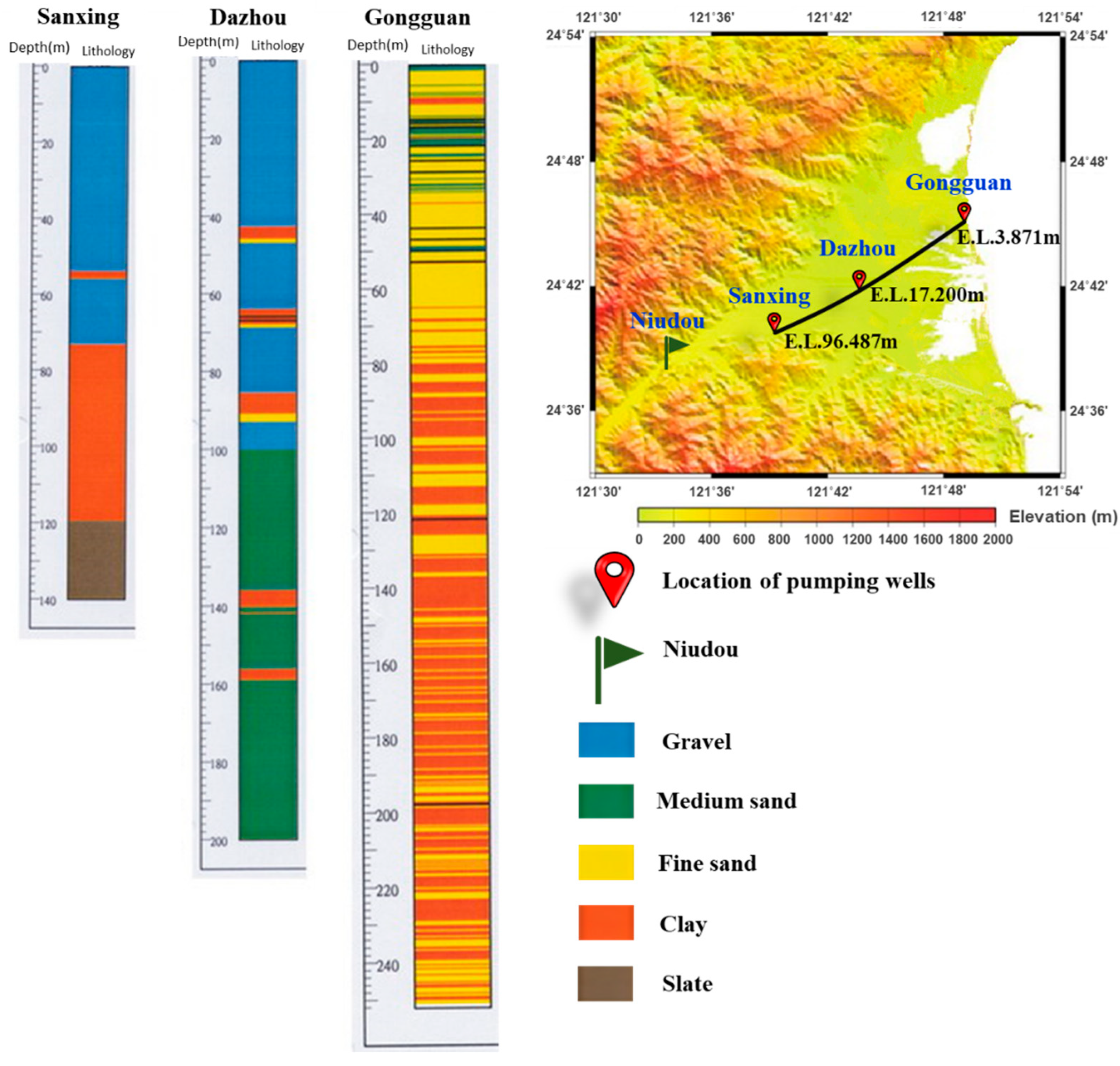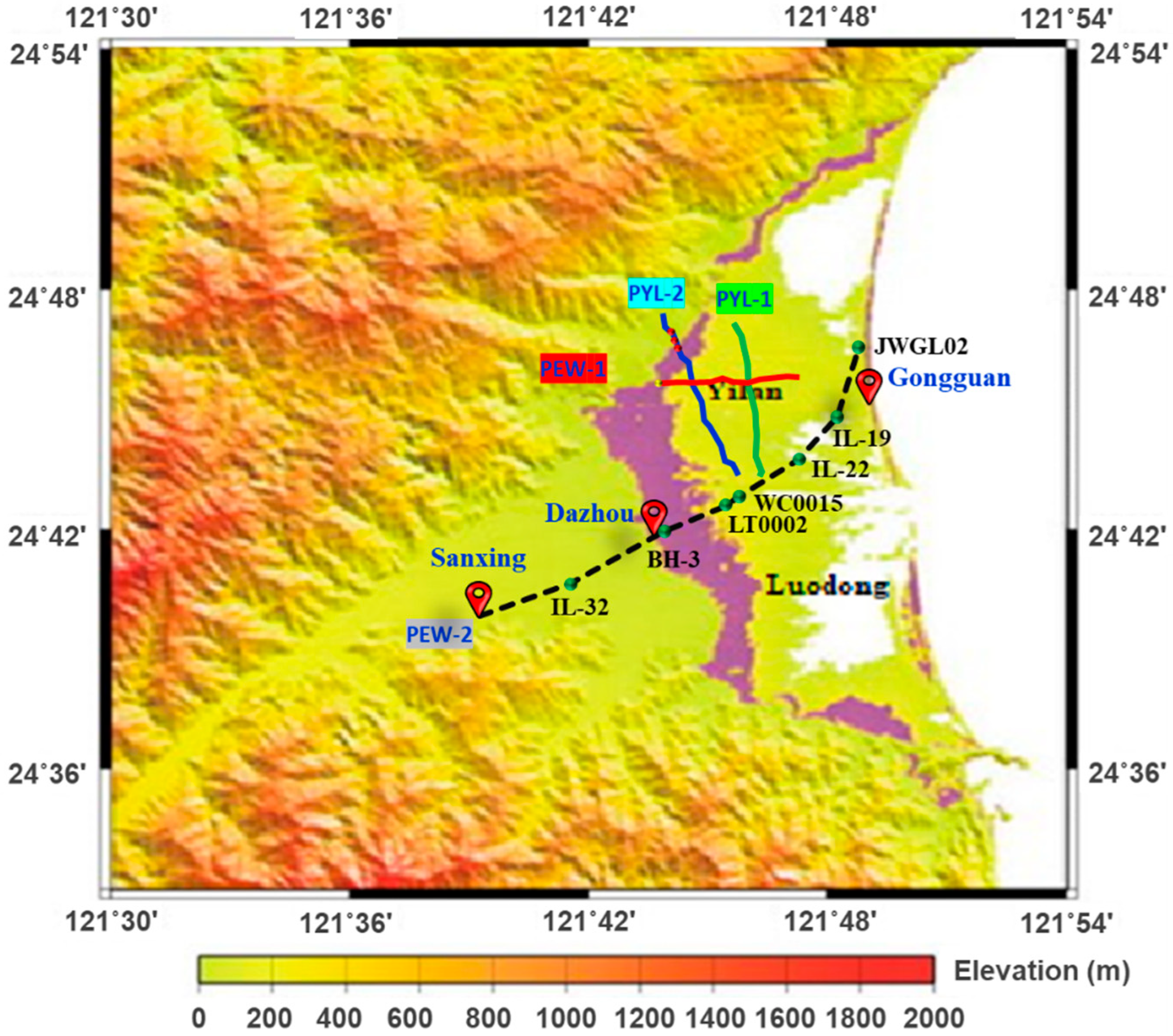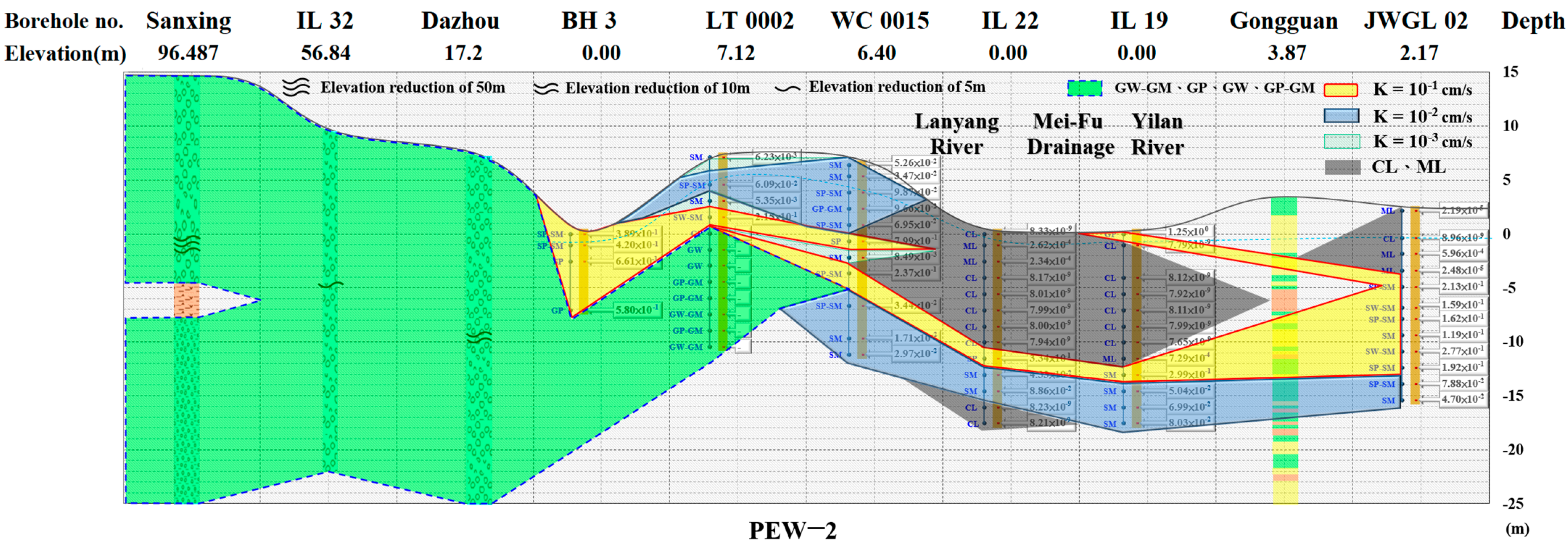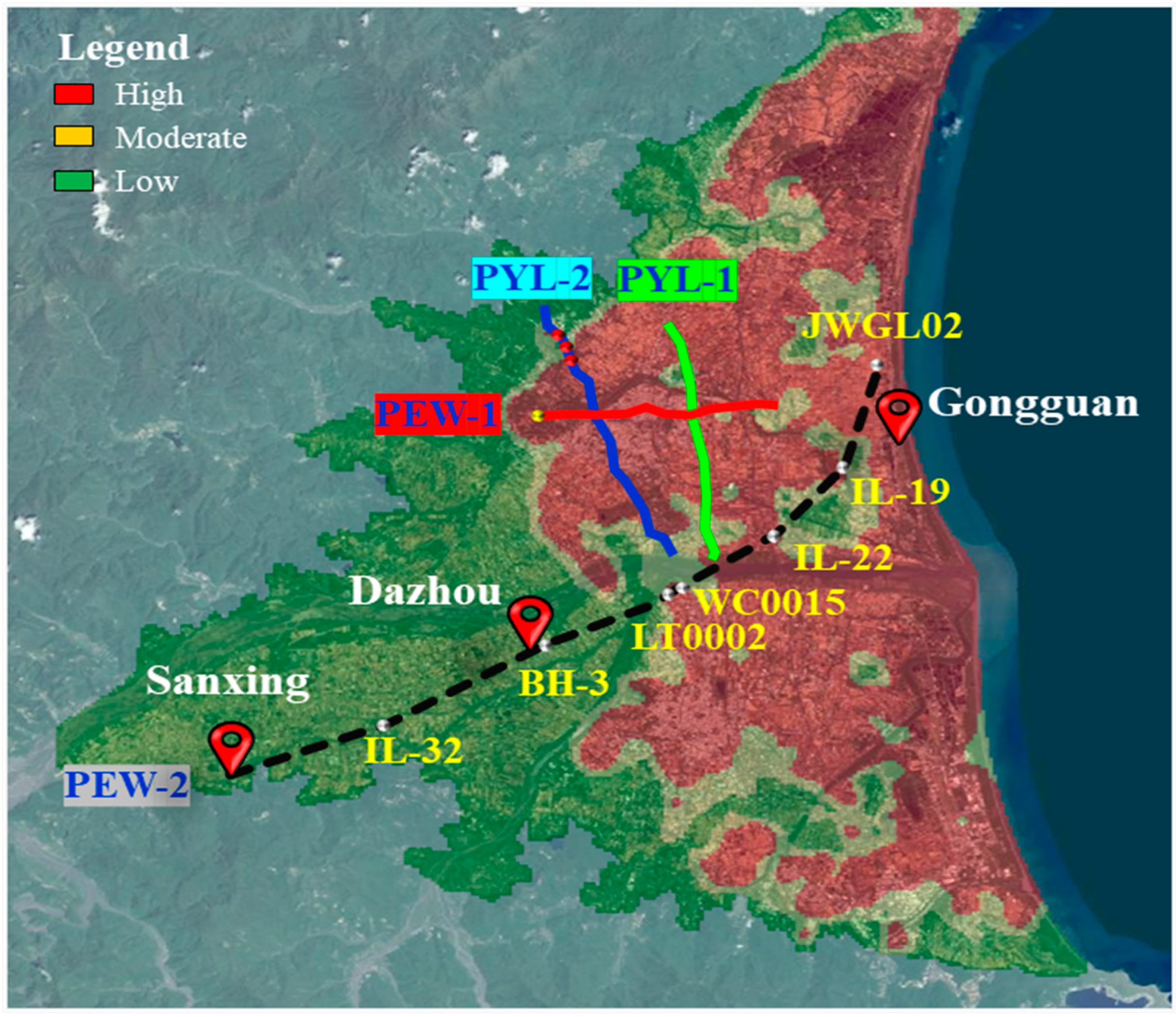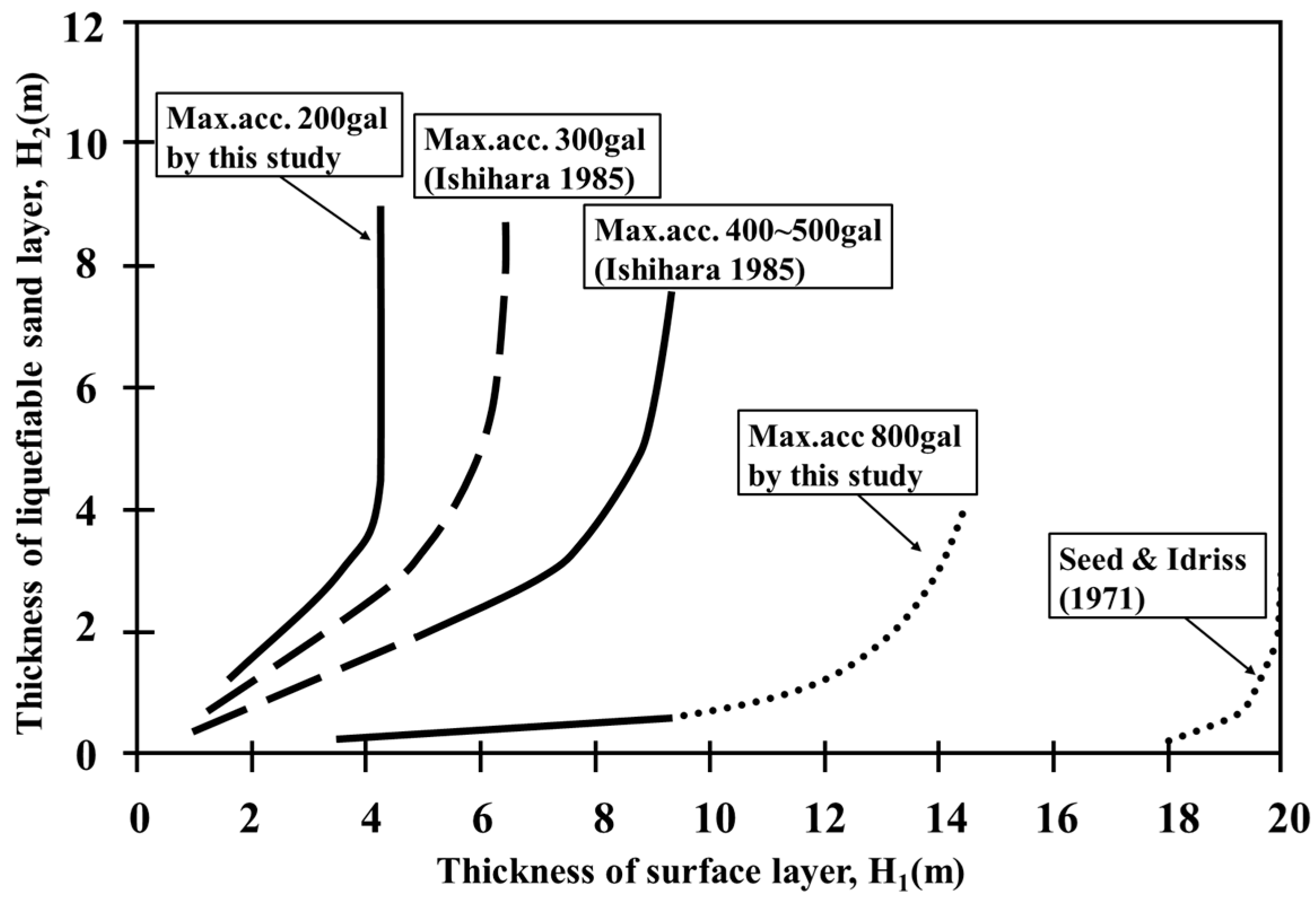2. Geological History of the Lanyang Plain
In the past ten years or so, the Water Resources Department Agency, MOEA has drilled more than 20 wells in the plain area to observe changes in the groundwater level in the Lanyang Plain. The depth of the wells is about 50–250 m. According to the drilling data of these wells, the sediments in the west of the plain are mainly gravel and sand, and the sediments in the east are mainly fine sand, silt, and mud [
6]. On the west side of the plain it is mostly dry land because it contains more sand and gravel, and the water is not easily retained in the soil. The drilling data also found that, except for the water wells near the mountainside, no rock base had been drilled. It can be seen that the thickness of the sediments in the plain must be hundreds of meters or more [
7].
The thickness of subsurface sediments on the Lanyang Plain was mapped by the seismic line survey conducted in 1976 for underground oil exploration (See
Figure 1). From the subsurface structures depicted in the north–south seismic section, we find that the thickness of sediments on the Lanyang Plain is the thickest in the center of the plain, about 1600 m or more, and gradually thins to the north, west, and south until it is extinct (see
Figure 2). It is in a dustpan shape with an opening toward the Pacific Ocean [
8].
The Lanyang plain main welling spring belt in
Figure 3 in the purple north and south belt area is a famous welling spring scenic area and distributes roughly in the elevation 7–15 m area [
10]. Examples are the crab bubbling pool in the canal of Yuansan Township, Arancheng swimming pool of Yuansan Township, Longtan swimming pool of Jiaoxi Township, the pine tree gate, and Longmu well in the winter mountain area, etc.
Chiang [
10] deduced: “When the Lanyang River enters the plain from the mountainous area near Niudou, the slope of the terrain becomes slower, the river surface gradually widens, and the flow velocity of the river decreases, so the gravel carried in the river begins to accumulate. Downstream of the river, the accumulated sediments became finer and finer, and finally only sand and mud are left over there (see
Figure 4)”. Together with the alluvial fans formed by other smaller rivers at their mouths, there are 17 alluvial fans of various sizes in the entire Yilan Plain. The common feature is that the gravel accumulation becomes finer and finer from upstream to downstream.
4. Permeability Analysis of the Lanyang Plain
This study takes the soil liquefaction problem as the main research focus; 659 Geological engineering drilling data are distributed in the plains east of Dazhou groundwater level measurement station. On average, four boreholes were arranged in every one square thousand meters. Yilan urban part has 218 boreholes, so the process was as follows. Draw three Geological engineering profile lines PYL-1, PYL-2, and PEW-1. “P” refers to profile, “YL” refers to Yilan, and “EW” refers to east and west. Then overlay the data of the three wells in
Figure 4 and
Figure 5, to obtain the profile line PEW-2. The borehole IL32, adopted from the website of Central Geological Survey [
14], is located in the west area, drilling depth 30 m, and the lithology is gray conglomerate. So, it is consistent with the geological conditions between the Sanxing borehole and Dazhou borehole.
Figure 6,
Figure 7,
Figure 8 and
Figure 9 are the profiles of PEW-1, PEW-2, and PYL-1, PYL-2. The profile line PEW-2 is the intersection of the study boreholes and the three wells in
Figure 3. (
Figure 6,
Figure 7,
Figure 8 and
Figure 9 data from [
1,
14]).
The Gongguan well in the east side in
Figure 7 is dominated by medium sand (green) and fine sand (yellow), and slight sediment (light red). The borehole JWGL02 on the downstream side of this study is consistent with this well, but the geological conditions of the borehole IL19 on the upstream side are different.
On the whole, the geological condition of the direction from the west to the upstream of the Dazhou borehole is just like the research description of Chiang [
10]. The lithology is a gray conglomerate, the permeability is excellent, and the mountain spring of the upstream of Lanyang stream is revealed in the brown area of the north–south direction in
Figure 5. The north–south direction welling spring area is represented by the Dazhou borehole with thickness of about 300 m. Following the geological engineering borehole data of this study, the stratigraphy and geological content of the PEW-2 section from west to east are explained in four sections.
The first section: the Sanxing drill hole to the west of the Dazhou drill hole between, gray gravel, permeability is good, natural welling spring appears.
The second section: between the east of the Dazhou borehole and the borehole WC0015, the ground below can be divided into three strata:
0–5 m, the permeability coefficient is about K = 1 × 10−2 cm/s, SM/SP-SM, medium sand, or coarse sand layer.
5–7 or 10 m, the permeability coefficient is about K = 1 × 10−1 cm/s, SP/SP-SM, coarse sand layer with excellent water permeability.
7 or 10 m below, gray gravel layer with excellent water permeability, or medium sand or coarse sand layer like the first layer.
The third section: between the east of drilling WC0015 and the west of the Dazhou drilling, the ground below can also be slightly divided into three strata:
0 m to 12 m, the permeability coefficient is about 1 × 10−9 cm/s, unify soil classification as CL/ML, poorly permeable sediment or clay layer.
12 m to 14 m, the permeability coefficient is about K = 1 × 10−1 cm/s, unify soil classification as SP/SM, coarse sand layer with excellent permeability.
14 m to 20 m, the permeability coefficient is about K = 1 × 10−2 cm/s, unify soil classification as SP/SM, medium sand, or coarse sand layer.
The fourth section: between the borehole of the Gongguan and the coast, the ground below can also be slightly divided into three strata.
0 m to 7 m, the permeability coefficient is about 1 × 10−9 cm/s, unify soil classification as CL/ML, poorly permeable sediment or clay layer.
7 m to 16 m, the permeability coefficient is about K = 1 × 10−1 cm/s, SP-SM/SM, coarse sand layer with excellent water permeability.
16 m to 20 m, the permeability coefficient is about K = 1 × 10−2 cm/s, unify soil classification as SM/SP-SM, medium sand, or coarse sand layer.
PEW-1 section is from welling spring area and is eastward of the Pacific Ocean. The stratum and geological conditions are similar to the profile PEW-2 from the second section to the fourth section. Therefore, it is divided into three sections for explanation.
The first section: (borehole YL0032-YL0085), has a double layer with excellent permeability coarse sand layer, the unified soil classification belongs to SP-SM/SW-SM, and the permeability coefficient is better than 1 × 10−1 cm/s.
The second section: (borehole YL0085-YL0038), with a double layer of medium or coarse sand with good permeability and a unified soil classification of SM/SW-SM, with a permeability coefficient of about K = 1 × 10−2 cm/s.
The third section: (borehole YL0038-YL0042), permeability poor, sink mud or clay layer as the main, unified soil classification belongs to CL/ML, permeability coefficient about K = 1 × 10−9 cm/s, depth 6 m to 9 m also has a layer about 3 m middle sand or coarse sand layer, unified soil classification belongs to SM/SP-SM.
PYL-2 profile is the north–south geological engineering profile line east of the welling spring area (see
Figure 5), which can be divided into five sections for explanation.
The first section: (borehole YL0001-YL0011), unified soil classification GW/GP-GM, permeability is excellent, gravel layer, permeability coefficient is better than 1 × 10−1 cm/s. This terrain forms natural welling spring.
The second section: (borehole YL0017-YL0022), permeability poor, sink mud or clay layer as the main soils, unified soil classification CL/ML, permeability coefficient about K = 1 × 10−9 cm/s. This section is north to GW/GP-GM, permeability excellent gravel layer, south to double, permeability good, middle sand or coarse sand layer, SM/SP-SM.
The third section: (borehole YL0023-YL0034). Interlayers of middle sand or coarse sand layer(SP-SM/SW-SM)and fine sand layer (SM) exist, with permeability coefficients of about 1 × 10−1 cm/s and 1 × 10−2 cm/s respectively.
The fourth section: (borehole YL0046-YL0060), with poor permeable sediment or clay layer, CL/ML permeability coefficient of about K = 1 × 10−9 cm/s, and only two thin fine sand (SM) interlayers layers of about 1.5 m each The soil properties of the fourth section are similar to the second section.
The fifth section: (The part-1 of boreholes YL0082-YL0072) Two layers of medium or coarse sand and fine sand exist among poor permeable clay layers. The medium or coarse sand (SP-SM/SW-SM) owns very good permeability of about K = 1 × 10−1 cm/s. The fine sand (SM/SW-SM) has a permeability coefficient of about K = 1 × 10−2 cm/s. (The part-2 of borehole YL0074) Poor permeable clay layer (CL/ML) is dominant, permeability coefficient is about K = 1 × 10−9 cm/s, and there is only one thin layer of medium sand (SM).
The PYL-1 profile is a north–south geological engineering profile line with stratigraphy and geology, which can be described in three sections.
The first section: (borehole YL0007-YL0038) has a double layer of medium sand or coarse sand with good permeability, SM/SW-SM, with a permeability coefficient of about K = 1 × 10−2 cm/s. and a coarse sand layer with excellent permeability, SP-SM, from about 0.5 m below the surface in borehole YL0016 to about 7 m below the surface in borehole YL0055, with a permeability coefficient better than 1 × 10−1 cm/s.
The second section: (borehole YL0055-YL0063) has a double layer of medium sand or coarse sand, SM, with a permeability coefficient of about K = 1 × 10−2 cm/s. There is also a coarse sand layer with good permeability and a fine sand layer with SP-SM/SM.
The third section: (borehole YL0081-YL0076) has a double layer of excellent permeability gravel layer and coarse sand layer interlayer GW-GM/SP-SM with permeability coefficient better than 1 × 10−1 cm/s. Borehole YL0076 has a layer of medium sand or coarse sand layer of about 3 m at an elevation of 6.5 m. Medium sand or coarse sand layer, SM with permeability coefficient about K = 1 × 10−2 cm/s.
Section Conclusion
Three permeability nomenclatures were used to classify the soil conditions in the Lanyang plain.
“Excellent permeability” was used for a gravel layer with permeability coefficient better than 1 × 10−1 cm/s.
“Very good permeability” was used for coarse sand layer with permeability coefficient about 1 × 10−1 cm/s.
“Good permeability” was used for fine sand layer with permeability coefficient about 1 × 10−2 cm/s.
The profile PEW-2, in the east–west direction; there are four different sections based upon permeable capacity. In the first section, exists a gravel layer with “excellent permeability.” In the second section, two “very good permeability” coarse sand layers exist with a gravel layer at the bottom. In the third section, 6.5 m thick impermeable clayey soil is the surface layer. In the fourth section, two “very good permeability” coarse sand layers exist with some clayey soil on top.
5. Analysis of Liquefaction in the Lanyang Plain
According to the soil liquefaction potential map published by the Central Geological Survey (hereinafter referred to as “CGS”) of the Ministry of Economic Affairs (MOEA), 69% of the soil in the Lanyang plain is at high liquefaction potential and the portion of Yilan city soil at high liquefaction potential is 78%. The liquefaction potential analysis was conducted following the Ministry of the Interior’s “Building Technology Regulations for Building Structures—Design Guidelines for Building Foundation Structures” “Building Seismic Design Guidelines and Explanations”, and the “New Japan Road Association Simple Experience Method” (JRA method) [
15]. In the evaluation of soil liquefaction potential, Yilan County used the seismic scale Mw = 7.3 according to the prescribed seismic scale correction factor, and then obtained the horizontal acceleration of small and medium seismicity, design seismicity, and maximum considered seismicity according to the calculation formula. The published soil liquefaction potential map of Yilan is based on a design earthquake horizontal acceleration of 0.32 g.
Figure 10 is the soil liquefaction potential map of the Yilan region published by the CGS [
16]. In this study, the four engineering profiles of PYL-1, PYL-2, PEW-1, and PEW-2 are mostly in the high liquefaction potential area. Except for the low liquefaction potential area from the Sanxing borehole to the west of the Dazhou borehole, the liquefaction potential of other boreholes from west to east are as follows: BH-3 shows low liquefaction potential, LT0002 shows high liquefaction potential, WC0015 shows high liquefaction potential, IL19 shows moderate liquefaction potential, and JWGL02 shows high liquefaction potential.
Analysis of Earthquake Data in Yilan Area
In 1980, the Institute of Earth Science (IES) of Academia Sinica, in collaboration with the University of California, Berkeley, established an intensive Phase I digital strong-motion seismometer array (SMART1, Strong Motion Array in Taiwan-1) [
17]. SMART1 is located in Luodong Township, Lanyang Plain (
Figure 11). SMART1 was designed to record high probability information of strong motions for earthquakes with M > 6.5. A total of 60 earthquakes were recorded in SMART1 between 1980 to1990, of which seven datum with PGA > 120 gals were used for soil liquefaction analysis (
Table 3). PEW-2 was selected for soil liquefaction analysis and overall description. Since the liquefaction assessment method of Seed et al. (1985) [
2] was strongly recommended by one of the authors in this study [
4,
5] as being the most accurate, this method was used to analyze the soil liquefaction potential in Yilan area, and then the depth-weighted method of Iwasaki [
18] was used to obtain the results shown in
Table 4 (
Table 4 data from [
1,
14]). The results of liquefaction potential were obtained by the depth-weighted method of Iwasaki et al. [
18]. In addition, the thickness H1 of the liquefaction impermeable layers by Ishihara [
3], and the thickness H1 suggested by one of the authors in this study [
19,
20], were used as the thickness of the upper cover layer to inhibit soil liquefaction under different seismic accelerations. In
Figure 12, some acceleration data as well as liquefaction symptom information were added into Ishihara‘s original figure. Two more lines, for PGA equaling 200 gals and 800 gals, are based upon Chi-Chi earthquakes data. Another line, for H1 equaling 20 m, is adopted from Seed and Idriss’s principle.
The section line PEW-2 except for the Sanxing drill hole to the west of the Dazhou drill hole belongs to the welling spring area, the other hole’s liquefaction potential situation from west to east after BH-3 presents very low liquefaction potential (PL = 0), LT0002 and WC0015 all present high liquefaction potential, IL22, and JWGL02 all present medium liquefaction potential; only IL19 presents low liquefaction potential.
The BH-3 drill hole is the most special of all the drill holes used for liquefaction analysis. The hole is adjacent to the east side of the welling spring area, 0–9 m for SP/SP-SM, SPT-N between 38 and 50, permeability is very good, a coarse sand layer, permeability coefficient about K = 1 × 10−1 cm/s, 9 m below for SPT-N ≥ 50 gravel layer, permeability is similar to the west side of the welling spring area, so, the seven seismic liquefaction analysis results are “0”, belonging to a very low liquefaction potential. We explain now the liquefaction potential of the second lightest borehole IL19, and the most serious borehole LT0002 in this paper.
Borehole IL19 stratigraphic distribution status 0–3 m has excellent permeability, a gravel layer with permeability coefficient better than 1 × 10
−1 cm/s, 3–14 m has 9.5 m thick clay layer and 1.5 m thick powder layer, 14–20 m is a medium and coarse sand layer, the permeability coefficient of this section is 1 × 10
−1 cm/s and 1 × 10
−2 cm/s respectively, good permeability of a double layer.
Table 9 shows that this layer is a liquefaction zone, and all of them have low liquefaction potential for the seven earthquakes. However, the thickness of the impermeable clay layer below the surface of the hole reached 9.5 m, which exceeded the proposed value of 6.5 m in
Figure 12. Therefore, we can conclude that the liquefaction behavior will be confined to the surface impermeable layer and no liquefaction symptom will be found around this borehole area.
Drill hole LT0002 showed high liquefaction potential during the No. 39 strong earthquake. Of the seven earthquakes, 2/7 (~29%) showed high liquefaction potential, 3/7 (~42%) showed moderate liquefaction potential, and 2/7 (~29%) showed low liquefaction potential. This is the hole with the most severe liquefaction potential compared to the other holes. Drill hole LT0002 stratum 0–8 m with a fine sand, medium sand, and coarse sand complex layer, below 8 m soil by GP, GW, GM combination and composition, that is, below 8 m there is gravel soil, and at the west side of the welling spring area link, permeability similar, but, standard penetration test only between 16 to 29, hardness is not as hard as drill hole BH-3 of gravel layer of SPT-N ≥ 50, showing a representative welling spring area gravel layer The east side of the boundary line should be in the BH-3 hole and LT0002 hole, and maybe a highly liquefied potential also beginning to the east gradually increasing. Fortunately, this hole of 0–8 m has a permeability coefficient of 1 × 10−2 cm/s of fine and middle sand layer, and a permeability coefficient of 1 × 10−1 cm/s of a coarse sand layer with excellent permeability, below 8 m it is connected to the gravel layer of the welling spring area, permeability is better, so the pore water pressure with earthquake liquefaction, will dissipate quickly because of the excellent permeability of the stratum, preventing the soil liquefaction phenomenon.
Drill hole WC0015 showed high liquefaction potential during the strong earthquake No. 39, and
Table 6 shows that the soil in 10/12 (about 83%) of the hole was liquefied. Under the analysis of liquefaction in the seven earthquakes, 1/7 (about 16%) showed high liquefaction potential, 3/7 (about 42%) showed medium liquefaction potential, and 3/7 (about 42%) showed low liquefaction potential, which is the second most severe hole. The stratigraphic distribution of drill hole WC0015 is 0–8 m with medium sand, coarse sand, and fine sand interlayers, and 8–20 m with gravelly soil. The depth from 11 m to 14 m should not liquefy since the standard penetration test results SPT-N are between 26 and 29. The liquefaction should occur at all other depths. Luckily, the hole depth of 8–17 m has two layers with a very good permeability coefficient of 1 × 10
−1 cm/s, and the upper and lower layers are also medium sand layers with a permeability coefficient of 1 × 10
−2 cm/s. So, the transient pore water pressure generated by the earthquake will dissipate quickly and no soil liquefaction phenomenon will occur.
Borehole IL22 is the third most severe hole in terms of liquefaction potential. 5/7 (about 71%) of the 7 seismic liquefaction analyses show moderate liquefaction potential and 2/7 (about 29%) show low liquefaction potential. There are 13 boreholes in
Table 8, IL22. At 0–12.5 m there are all non-liquefied impermeable layers with about a 9.5 m thick clay layer and a 3 m thick chalk layer. At 12.5–18 m is a double layer with good permeability with medium and coarse sand layer, and the permeability coefficient of this section is between 1 × 10
−1 and 1 × 10
−2 cm/s. At 18–21 m there is a clay layer. In the liquefaction analysis of the strong earthquake No. 39,
Table 8 shows that the hole is determined to be of medium liquefaction potential according to the analysis, but in terms of stratigraphic distribution, the thickness of the clay and powder layer in the whole section reached 12.5 m, covering the liquefied sand layer. Thus, the ground surface is not liquefied according to
Figure 12.
Borehole JWGL02 is the fourth most severe hole in terms of liquefaction potential, with 2/7 (about 29%) showing medium liquefaction potential and 5/7 (about 71%) showing low liquefaction potential. Borehole JWGL02 has a thick chalk layer with clay from 0 m to 8.5 m, and a double layer with good permeability of medium and coarse sand from 8.5 m to 21 m. The permeability coefficient of this section is between 1 × 10−1 and 1 × 10−2 cm/s. Although the SPT-N value is not large enough for liquefaction, the coarse sand layer with good permeability can quickly remove the transient high pore water during the earthquake and prevent soil liquefaction.
In the Seismic Information Center of the Central Weather Bureau of the Ministry of Transportation and Communications, in this study the earthquakes were searched with magnitudes larger than 4 and Intensity larger than 5 in Yilan City from 1999 to 2021.
Table 11 shows only eight events as required and the maximum PGD is 175.74 gals.
To cause a high liquefaction potential in Lanyang Plain,
Table 4 shows that a PGA larger than 283.4 gals is necessary while 237.73 gals are required for a moderate liquefaction potential. So, only a low liquefaction potential might have occurred in the last 23 years in the Lanyang Plain. Event 39 with PGA equaling 375.34 gals is a very specific case only recorded by the SMART-1 array in Luodong town by the IES of Academia Sinica. Even the Seismic Information Center of the Central Weather Bureau does not own such a record. More, the design earthquake horizontal acceleration of 0.32 g, which is required by the “Building Seismic Design Guidelines and Explanations” of the Ministry of the Interior, was used by the CGS to build a liquefaction potential map of Lanyang Plain. Therefore, 69% of high liquefaction potential was shown for the Lanyang Plain but no serious liquefaction report was announced in practice.
6. Conclusions
The seven earthquakes since 1980, with peak ground acceleration larger than 120 gals, occurring in the Lanyang Plain were used to examine the practical liquefaction potential in the Yilan area in this study. The largest PGA (375.34 gals = 0.383 g) was input into the six boreholes in geotechnical profile PEW-2 for soil liquefaction analysis. The hole BH-3 shows very low liquefaction potential (PL = 0), which is the lowest liquefaction potential hole in this study. Although moderate and high liquefaction occurred in boreholes LT0002, WC0015, and JWGL02, soil liquefaction was not observed in the ground surface because the transient high pore water was removed very quickly by the existence of a coarse sand layer with very good permeability, and a gravel layer with excellent permeability. Borehole IL22 and Borehole IL19 are covered with an impermeable layer of more than 6.5 m in thickness, so the soil liquefaction is confined to the deep underground and is not seen on the ground surface.
To sum up, the stratum of the Lanyang Plain contains a gravel layer with excellent permeability and a coarse sand layer with very good permeability, so the drainage condition is extremely ideal. Hence, the high pore water pressure due to earthquake compression behavior can be eliminated and dissipated instantly without causing a soil liquefaction disaster when an earthquake occurs. On the other hand, because the soil is covered with impermeable layers of more than 6.5 m, the liquefied sand layer underneath does not flow to the surface. Therefore, no signs of soil liquefaction can be seen on the ground surface.
In addition, by using 0.32 g for the assumed possible earthquakes occurring, more than 69% of the plain area was shown with high liquefaction potential in the Central Geological Survey’s soil liquefaction potential map of the Lanyang Plain. However, it did not happen in the last 23 years in the Lanyang Plain according to the SIC records of CWB.
Earthquakes with PGA (375.34 gals) are again assumed to have happened nearby to these six boreholes in Lanyang Plain and initiated some high liquefaction. However, it only existed in Lotung county in reality and was only recorded by academic research sensors. Earthquakes with PGA larger than 237.73 gals will cause moderate liquefaction in Yilan area. However, no such earthquake occurred based upon SIC reports of CWB from 1999 to 2021.
As a result, the residents of Yilan have had no opportunity to see an actual liquefaction phenomenon in the last 23 years.

